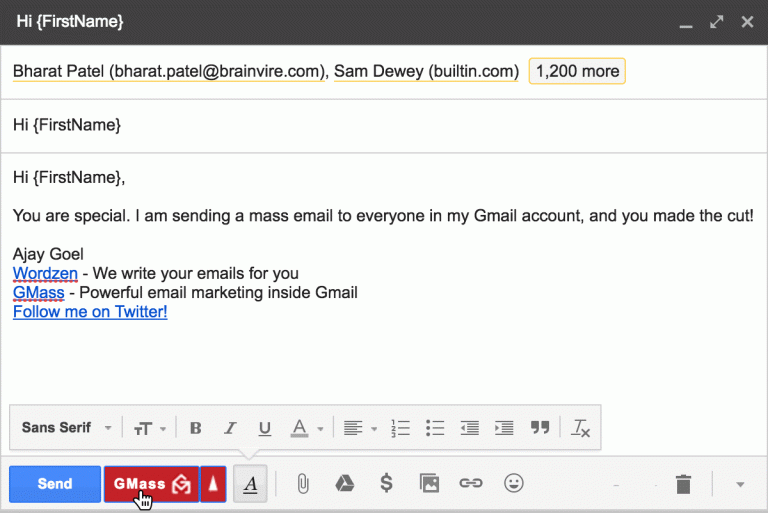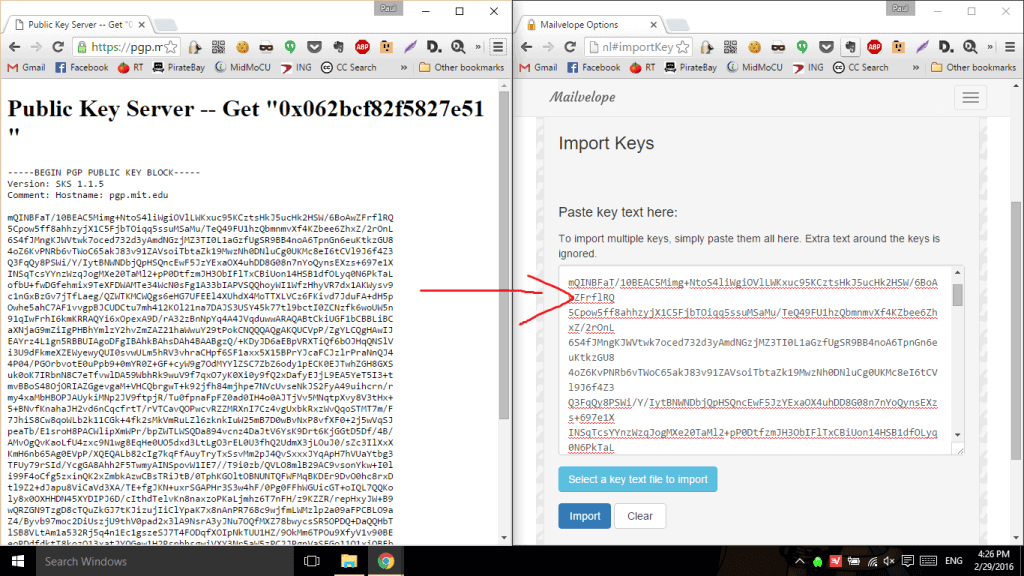Blind carbon copy (abbreviated Bcc) allows the sender of a message to conceal the person entered in the Bcc field from the other recipients. This concept originally applied to paper correspondence and now also applies to email.[1]
My Bcc Email
In some circumstances, the typist creating a paper correspondence must ensure that multiple recipients of such a document do not see the names of other recipients. To achieve this, the typist can:
- Add the names in a second step to each copy, without carbon paper; Copy Circulation
- Set the ribbon not to strike the paper, which leaves names off the top copy (but may leave letter impressions on the paper).
Tomb raider 9 for mac. If you send an email and list recipients in the BCC fields then only the sender should be able to see the BCC recipients. If the BCC recipients are a mixture of gmail accounts and non-gmail then the non-gmail accounts do not see the BCC lits (which is correct). The way Bcc is designed is specified in RFC 2822, under section 3.6.3. To quote the specification: The 'Bcc:' field (where the 'Bcc' means 'Blind Carbon Copy') contains addresses of recipients of the message whose addresses are not to be revealed to other recipients of the message. There are three ways in which the 'Bcc:' field is used. In email, CC stands for carbon copy, while BCC stand for blind carbon copy. Those email addresses listed under CC in an email get a copy of the email, and everyone on the list can see who they are. Those email addresses listed under BCC receive an email, but it is not visible to other recipients. I send emails with BCC'd addresses on a daily basis (from my personal Hotmail and my Office 365 accounts), and the only time I experienced exactly the same issue you had with BCC'd email addresses. Just like CC, BCC is a way of sending copies of an email to other people. The difference between the two is that, while you can see a list of recipients when CC is used, that's not the case with BCC. It's called blind carbon copy because the other recipients won't be able to see that someone else has been sent a copy of the email.
How To Send Bcc Emails
With email, recipients of a message are specified using addresses in any of these three fields:

- To: Primary recipients
- Cc: Carbon copy to secondary recipients—other interested parties
- Bcc: Blind carbon copy to tertiary recipients who receive the message. The primary and secondary recipients cannot see the tertiary recipients. Depending on email software, the tertiary recipients may only see their own email address in Bcc, or they may see the email addresses of all primary and secondary recipients but will not see other tertiary recipients.
It is common practice to use the Bcc: field when addressing a very long list of recipients, or a list of recipients who should not (necessarily) know each other, e.g. in mailing lists.[2]
Benefits[edit]
There are a number of reasons for using this feature:
- Bcc is often used to prevent an accidental 'Reply All' from sending a reply intended for only the originator of the message to the entire recipient list.[3]
- To send a copy of one's correspondence to a third party (for example, a colleague) when one does not want to let the recipient know that this is being done (or when one does not want the recipient to know the third party's e-mail address, assuming the other recipient is in the To: or Cc: fields).
- To send a message to multiple parties with none of them knowing the other recipients. This can be accomplished by addressing a message to oneself and filling in the actual intended recipients in the Bcc: field. However, this does not ensure that the Bcc: addresses will be hidden from other Bcc: addresses in all implementations.[citation needed] However, in Gmail, it is possible to send a message with only bccs and/or 'cc:'s, so addressing it to one's self is not always necessary.
- To prevent the spread of computer viruses, spam, and malware by avoiding the accumulation of block-list e-mail addresses available to all Bcc: recipients, which often occurs in the form of chain letters.
Disadvantages[edit]
In some cases, the use of blind carbon copy may be viewed as mildly unethical. The original addressee of the mail (To: address) is left under the impression that communication is proceeding between the known parties, and is knowingly kept unaware of others participating in the primary communication.
A related risk is that by (unintentional) use of 'reply to all' functionality by someone on Bcc, the original addressee is (inadvertently) made aware of this participation. For this reason, it is in some cases better to separately forward the original e-mail.
Depending on the particular email software used, the recipient may or may not know that the message has been sent via Bcc. In some cases, 'undisclosed recipients' placed in the To: line (by the software) shows that Bcc has been used. In other cases, the message appears identical to one sent to a single addressee. The recipient does not necessarily see the email address (and real name, if any) originally placed in the To: line.
When it is useful for the recipients to know who else has received a Bcc message,
- their real names, but not their email addresses, can be listed in the body of the message, or
- a meaningful substitute for the names can be placed in the body of the message, e.g. '[To General Manager and members of Remunerations Committee]', or '[To the whole Bloggs family]'.
Carbon vs. courtesy[edit]
The interpretation of 'Bcc:' as 'blind courtesy copy' is a backronym and not the original meaning; the historic RFC 733 has an explicit 'blind carbon' annotation in its definition of the Bcc: header field syntax. 'Cc:' and 'Bcc:' mean 'carbon copy' and 'blind carbon copy' respectively.
Sending courtesy copies of mailing list replies also directly to the author(s) of answered message(s) is a common practice on some lists,[citation needed] and matches a new interpretation of 'Cc:' as abbreviation for 'courtesy copy'.[dubious]
See also[edit]
References[edit]
- ^Stout, Chris. 'DEAR NERD: Blind carbons hide addresses.' Charleston Gazette (West Virginia, USA). 1998-01-18. page P5B. NewsBank record number 100F35638A890441.
- ^Husted, Bill. 'Bad e-mail habits can be bothersome, embarrassing'. The Atlanta Journal-Constitution (Georgia, USA). 2009-08-30. page E15. NewsBank record number 103419444.
- ^Boodhoo, Niala; Carey, Bridget (2009-08-25). 'Be careful when you 'reply all' to e-mail'. Miami Herald. pp. C8. NewsBank record number 200908250100KNRIDDERFLMIAMIH_poked-08-25-09.

- To: Primary recipients
- Cc: Carbon copy to secondary recipients—other interested parties
- Bcc: Blind carbon copy to tertiary recipients who receive the message. The primary and secondary recipients cannot see the tertiary recipients. Depending on email software, the tertiary recipients may only see their own email address in Bcc, or they may see the email addresses of all primary and secondary recipients but will not see other tertiary recipients.
It is common practice to use the Bcc: field when addressing a very long list of recipients, or a list of recipients who should not (necessarily) know each other, e.g. in mailing lists.[2]
Benefits[edit]
There are a number of reasons for using this feature:
- Bcc is often used to prevent an accidental 'Reply All' from sending a reply intended for only the originator of the message to the entire recipient list.[3]
- To send a copy of one's correspondence to a third party (for example, a colleague) when one does not want to let the recipient know that this is being done (or when one does not want the recipient to know the third party's e-mail address, assuming the other recipient is in the To: or Cc: fields).
- To send a message to multiple parties with none of them knowing the other recipients. This can be accomplished by addressing a message to oneself and filling in the actual intended recipients in the Bcc: field. However, this does not ensure that the Bcc: addresses will be hidden from other Bcc: addresses in all implementations.[citation needed] However, in Gmail, it is possible to send a message with only bccs and/or 'cc:'s, so addressing it to one's self is not always necessary.
- To prevent the spread of computer viruses, spam, and malware by avoiding the accumulation of block-list e-mail addresses available to all Bcc: recipients, which often occurs in the form of chain letters.
Disadvantages[edit]
In some cases, the use of blind carbon copy may be viewed as mildly unethical. The original addressee of the mail (To: address) is left under the impression that communication is proceeding between the known parties, and is knowingly kept unaware of others participating in the primary communication.
A related risk is that by (unintentional) use of 'reply to all' functionality by someone on Bcc, the original addressee is (inadvertently) made aware of this participation. For this reason, it is in some cases better to separately forward the original e-mail.
Depending on the particular email software used, the recipient may or may not know that the message has been sent via Bcc. In some cases, 'undisclosed recipients' placed in the To: line (by the software) shows that Bcc has been used. In other cases, the message appears identical to one sent to a single addressee. The recipient does not necessarily see the email address (and real name, if any) originally placed in the To: line.
When it is useful for the recipients to know who else has received a Bcc message,
- their real names, but not their email addresses, can be listed in the body of the message, or
- a meaningful substitute for the names can be placed in the body of the message, e.g. '[To General Manager and members of Remunerations Committee]', or '[To the whole Bloggs family]'.
Carbon vs. courtesy[edit]
The interpretation of 'Bcc:' as 'blind courtesy copy' is a backronym and not the original meaning; the historic RFC 733 has an explicit 'blind carbon' annotation in its definition of the Bcc: header field syntax. 'Cc:' and 'Bcc:' mean 'carbon copy' and 'blind carbon copy' respectively.
Sending courtesy copies of mailing list replies also directly to the author(s) of answered message(s) is a common practice on some lists,[citation needed] and matches a new interpretation of 'Cc:' as abbreviation for 'courtesy copy'.[dubious]
See also[edit]
References[edit]
- ^Stout, Chris. 'DEAR NERD: Blind carbons hide addresses.' Charleston Gazette (West Virginia, USA). 1998-01-18. page P5B. NewsBank record number 100F35638A890441.
- ^Husted, Bill. 'Bad e-mail habits can be bothersome, embarrassing'. The Atlanta Journal-Constitution (Georgia, USA). 2009-08-30. page E15. NewsBank record number 103419444.
- ^Boodhoo, Niala; Carey, Bridget (2009-08-25). 'Be careful when you 'reply all' to e-mail'. Miami Herald. pp. C8. NewsBank record number 200908250100KNRIDDERFLMIAMIH_poked-08-25-09.
External links[edit]
- US-CERTCyber Security Tip ST04-008, 'Benefits of BCC'

